NETWORKDAYS.INTL function - The function returns the number of whole working days between 2 dates, specifying weekends in Excel
The following article introduces you to the NETWORKDAYS function - one of the functions in the date and time group function very popular in Excel.

Description: The function returns the number of whole working days between two dates by using a parameter that determines the number of weekends and which day of the week.
Syntax: NETWORKDAYS.INTL (start_date, end_date, [weekend], [holidays])
Inside:
- start_date: Start date to calculate the number of working days, is a required parameter.
- end_date: The end date to calculate the number of working days, which is a required parameter.
- weekend: The method of calculating the number of weekends is not counted in the working day, including the values:
+ weekend = 1 or skip -> Weekends are Saturdays and Sundays.
+ weekend = 2 -> The weekend is Sunday, Monday.
+ weekend = 3 -> Weekends are Monday and Tuesday.
+ weekend = 4 -> Weekends are Tuesday and Wednesday.
+ weekend = 5 -> Weekends are Wednesdays and Thursdays.
+ weekend = 6 -> Weekends are Thursdays and Fridays.
+ weekend = 7 -> Weekends are Fridays and Saturdays.
+ weekend = 11 -> Sunday weekends.
+ weekend = 12 -> The weekend is Monday.
+ weekend = 13 -> The weekend is Tuesday.
+ weekend = 14 -> Weekend is Wednesday.
+ weekend = 15 -> The weekend is Thursday.
+ weekend = 16 -> The weekend is Friday.
+ weekend = 17 -> Weekends are Saturdays.
- holidays: Holidays need to be excluded from the working day, these days are usually not on a fixed list, is an optional parameter.
Attention:
- If start_date > end_date -> The return value is negative and the magnitude of the value will be the number of complete working days.
- If the value of start_date or end_date is outside the current date range -> the function returns the #NUM! Error value
- If the weekend value is not valid -> the function returns the #VALUE! Error value
For example:
Calculate the number of whole working days to know the number of weekends not counted in working days.

In the cell to calculate enter the formula: = NETWORKDAYS.INTL (E7, F7, G7, H7).
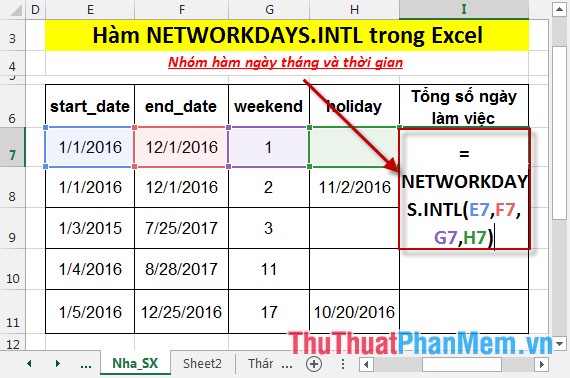
- Press Enter -> return value is:
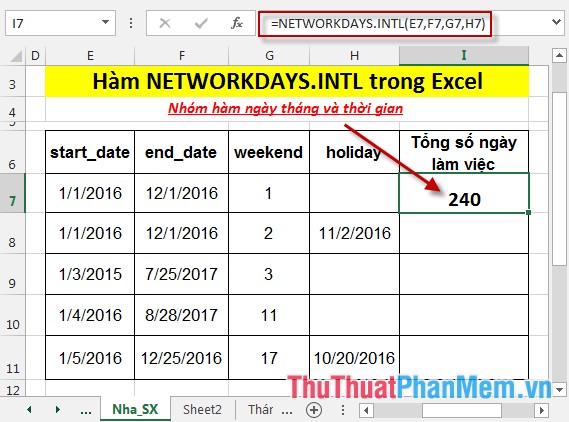
Here the total number of working days is 240 days except Saturday and Sunday not working and the total has 40 Sundays and 40 Saturdays.
- Similarly, there is an extra day off -> number of working days is:
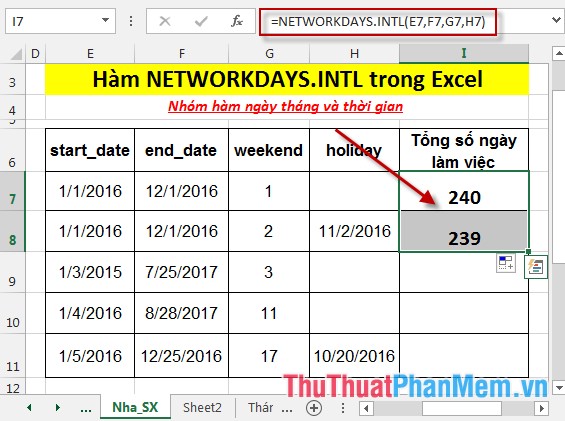
- Copy the formula for the remaining values to get the result:
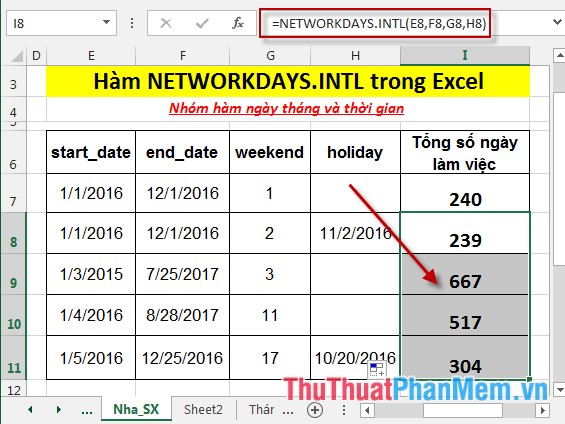
- Where start_date > end_date -> return value is less than 0 -> actual number of working days in the past.
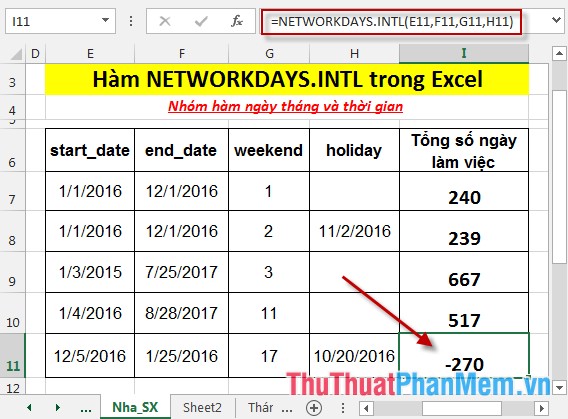
Here the value is -270 -> past working days is 270 days.
Above are instructions and some specific examples when using NETWORKWEEKDAYS.INTL function in Excel.
Good luck!
You should read it
- DAYS360 function - The function returns the number of days between 2 dates, based on 360 days in Excel
- The WORKDAY.INTL function - The function returns a date before or after the date starting with a custom weekend in Excel
- The WORKDAY function - The function returns a date before or after the start date of a number of working days in Excel
- YEARFRAC function - The function returns the fifth calculated by the number of whole days between two specific dates in Excel
- DATEDIF function - The function calculates the number of days, months, years between 2 dates in Excel
- DAYS function, how to use the function to calculate the number of days between two time points in Excel
 DATEDIF function - The function calculates the number of days, months, years between 2 dates in Excel
DATEDIF function - The function calculates the number of days, months, years between 2 dates in Excel DATEVALUE function - Functions to convert text format dates to serial numbers in Excel
DATEVALUE function - Functions to convert text format dates to serial numbers in Excel DAY function - The function returns the date value of a specific date in Excel
DAY function - The function returns the date value of a specific date in Excel The DAYS function - The function returns the number of days between 2 dates in Excel
The DAYS function - The function returns the number of days between 2 dates in Excel DAYS360 function - The function returns the number of days between 2 dates, based on 360 days in Excel
DAYS360 function - The function returns the number of days between 2 dates, based on 360 days in Excel EDATE function - Add and subtract months to a specified date in Excel
EDATE function - Add and subtract months to a specified date in Excel